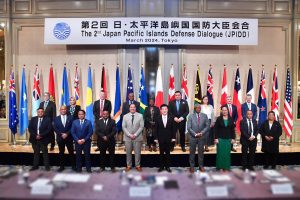In July 2024, the 10th Pacific Islands Leaders Meeting (PALM) will be held in Tokyo. The PALM summits have been bringing together Japan and the Pacific Island countries (PICs) on a triennial basis since 1997. On this occasion, Japan might propose a security cooperation agreement to the countries of the region. Indeed, the expansion of security and defense cooperation stands as the most spectacular change in Japan’s contribution to the region in recent years.
The Pacific territories hold significant wealth in fishery resources and raw materials, including critical minerals. Their sea lanes are crucial for Tokyo’s energy supplies, and their strategic geographical location is vital amid China-U.S. rivalry. Additionally, these territories play a key role in realizing Japan’s vision for a Free and Open Indo-Pacific. These factors underscore Japan’s strong interests in the region and explain the rise in strategic engagement.
As a major provider of Official Development Assistance (ODA), Tokyo has developed innovative tools to help strengthen the maritime surveillance capabilities of the PICs, and more broadly, their resilience to climatic and geopolitical risks. From its low-profile beginning, focusing on non-traditional challenges and led by civilian actors, security cooperation has grown to be more visible, with the increased participation of Japan’s Self-Defense Forces (SDF) and in cooperation with like-minded partners such as United States and Australia. As a result, Tokyo has positioned itself as a security provider in the Pacific Islands, developing a multifaceted and integrated approach.
Tokyo began providing aid to the Pacific islands in the 1970s, when the establishment of Exclusive Economic Zones (EEZs) was under discussion and Tokyo wanted to ensure access for its fishing vessels. Today Japan is the region’s third-largest donor, behind Australia and New Zealand.
In 1997, nine years before China, and at a time when the United States and other major donors were disengaging from the area, Tokyo set up a triennial high-level forum to meet its Pacific partners. The PALM summit initiated a multilateral political dialogue, initially bringing together 16 countries in the region, and accompanied the expansion of Japanese aid.
Japan’s security cooperation has therefore primarily involved development aid and has focused on strengthening the maritime surveillance and policing capacities of Micronesian states, which are historically and geographically closer to Japan. It has been mostly implemented by civilian actors.
By operating in this manner, Tokyo could meet the expectations of Pacific states seeking assistance in monitoring their EEZs and combating illegal fishing. At the same time, Japan could act with discretion to secure approval from both Canberra and Washington, who were previously the sole providers of patrol boats for the PICs.
Security cooperation has gradually evolved to include Japan’s Ministry of Defense, which launched its own capacity-building program in 2012.

































